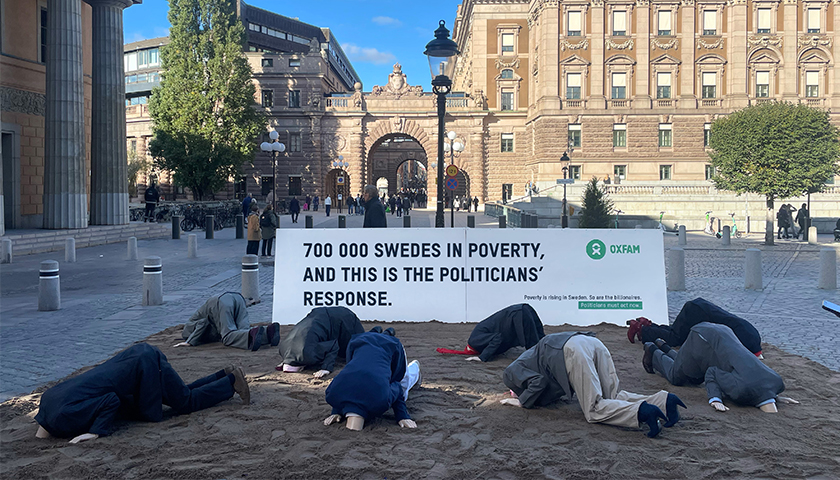Finding safe water supplies for drought-stricken communities is becoming increasingly difficult as a result of climate change, Oxfam warned as it published a report warning of the dire humanitarian cost of increased water scarcity.
The report, Water Dilemmas, describes how a water security crisis, in large part driven by global heating from greenhouse gas emissions, will fuel hunger and disease and force more people to leave their homes.
Nafkote Dabi, Oxfam Global Climate Justice Lead, said: “Water is the lifeblood of communities across the globe, but climate change means that for many it is an increasingly a scarce resource. This poses one of the biggest threats to humanity and will lead to more hunger, more disease and more displacement, especially for the countries and communities least prepared for climate change.”
Using data projections Oxfam found that:
- By 2040, East Africa could be hit by a cycle of even more intense floods and droughts with an eight per cent rise in precipitation leading to a potentially catastrophic 30 percent rise in surface runoff. This washes away nutrients from exhausted soils and destroys infrastructure. The region could also face a dramatic increase in mosquito-borne diseases, meaning 50-60 million more people in the region could be at risk of malaria by 2030.
- Both East Africa and West Africa are facing 8-15 per cent more intense heatwaves and falls in labour productivity of 11-15 per cent, amid mass migration, rising poverty and hunger, crop changes and livestock loss, and more water-driven conflicts.
- In the Middle East, rainfall will decrease markedly by 2040, sparking worsening food security. Heatwaves will rise by 16 per cent, leading to a drop in labour productivity of 7 per cent, with water prices expected to rise sharply.
- Countries across Asia meanwhile will be affected more by rising sea-levels, potentially over half a metre by 2100. Along with surface run-off and glacier melt, this will affect fresh groundwater aquifers, especially in coastal areas where hundreds of millions of people live. Diseases like malaria and dengue could rise by a staggering 183 per cent and the region could experience more heatwaves, an eight per cent rise, and a decline in labour productivity, by seven per cent, leading to more poverty and migration.
In East Africa, over 32 million people are facing acute hunger and starvation because of a five-season drought, made worse by conflict and poverty. Meanwhile, other parts of the region are being hit by destructive flash floods and unpredictable rains, devastating people’s crops and livelihoods.
Oxfam in Africa Water and Sanitation Lead, Betty Ojeny, who is working on Oxfam’s East Africa response, said: “We’re seeing climate change biting now and these problems are only going to get worse. One in five boreholes we dig now ends up dry or with water that is unfit for humans to drink.
“We have to dig deeper wells, through baked soils, which means more expensive breakages and we’re having to use expensive desalination technologies that are sometimes glitchy, especially in the more hostile terrains where we have to work. This is also happening at a time when donor funding for water is declining.
“In South Sudan flooding is washing away sanitation facilities and submerging boreholes, rendering them useless. More water-borne diseases like cholera are putting immense pressure not only on our water and sanitation work, but also stretching our public health operations too.”
The reports says that decades of underinvestment in water systems, poor water management, and erosion, pollution and overuse of subterranean aquifers are worsening this water crisis. Millions of already vulnerable people are now left ill-equipped to face the harmful consequences of the climate crisis. Only 32 per cent of the $3.8 billion (£2.9 billion) global UN humanitarian appeals for water and sanitation was funded last year and countries most at risk of water insecurity are failing to invest in water infrastructure.
According to the United Nations, 2.3 billion people currently do not have access to safe drinking water and a further 3.6 billion people don’t have safe sanitation. Others have warned that the world will face a 40 per cent shortfall in fresh water supply by the end of the decade. Even parts of the UK could face a water deficit by 2050, despite the fact the country has been drenched by one of the wettest summers on record.
Dabi said: “Global warming is increasing the frequency and severity of disasters, including floods and droughts, which will be hitting countries harder and more often in years to come. The huge lack of investment in strengthening water systems is leaving countries open to catastrophe.
“Under today’s emissions trajectories, billions of people face no safe future in the worsening water crisis. Rich polluting nations must immediately and drastically cut their emissions, and fund water infrastructure in poor communities. We are still able to alter course toward safety if we choose, but we must act fast.”


